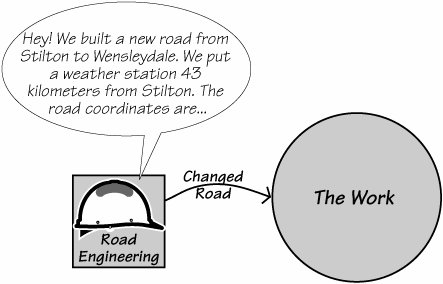Business Events
| Any system or piece of work responds to things that happen outside it. It's that simple. For the sake of clarity, because we are discussing your customer's work or business, we shall call these happenings business events. Let's look at one. Suppose you bought this book in a bookshop. You found it on the shelf, thought it was useful and interesting, and approached the cash desk. That moment, the instant you signaled your intention to buy the book, is the business event. The sales assistant responded to this business event by scanning the bar code, asking you for the cover price plus any applicable tax, perhaps asking the credit card company for authorization, ringing up the sale at the cash register, and putting the book in a bag before handing it to you. That, or something similar, is the bookshop's preplanned response to that particular business event. We call this response to the business event a business use case. When you pay your credit card bill at the end of the month, it is a business event as seen from the point of view of the credit card company. The credit card company responds to this event (its business use case) by checking that your address has not changed and then recording the date and amount of your payment.
In both exampleswhen you commit to buy the book and when you decide to pay your monthly billyou cause a business event to happen. The piece of work that you affectselling books or recording paymentsis a business use case, which is the work's preplanned response to the event. You do not own or control either the bookshop or the credit card company. Nevertheless, in both cases you do something to make them respond by doing some processing and manipulating some data. Think of it this way: Those pieces of work have a preplanned business use case, which is activated whenever an outside body (the adjacent system) initiates a business event. Figure 4.3 illustrates this idea. Figure 4.3.A business event takes place outside the scope of the work. The work learns that it has happened through the arrival of an incoming flow of information. The work contains a business use case to respond to this business event. Note that business use cases are triggered by the arrival of an information flowthe book and your payment at the cash desk, and your payment slip and check at the credit card companyfrom an adjacent system. As a consequence, the responsibility for triggering the business use case lies outside the control of the work. We will return to this point shortly. First, however, let's look at another kind of business event.
When a business event happens, the work responds by initiating a business use case. |
EAN: 2147483647
Pages: 371
